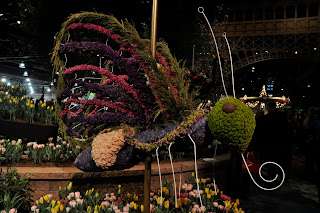by: Claire Hudson
 |
| Vincent van Gogh, "Rain", 1889, Oil on Canvas |
The rain slaps the window and patters to the field below, as the sky billows-- a steely gray blanket. You feel cold, but thrilled at the passion of the rain as it beats down from the sky. This is a moment that will last only as long as the storm itself, but is forever captured in Van Gogh’s 1889 painting
Rain.
The ability to capture the emotion of a moment is one that is immensely hard to attain; as artists, it is an ability we all covet and wish to utilize. Van Gogh does just this through his application of paint. What is so striking to me about Van Gogh’s
Rain is the passion of the strokes, and the gentleness of the colours. Van Gogh’s brush strokes appear so quietly aggressive, that I felt slightly taken aback at being drawn in so close. The ferociousness of the rain paired with the overlapping blues, greens, and pale yellows, create a stunning juxtaposition conveying an unease that is appealing and difficult to ignore.
Compositionally and technically, Van Gogh utilized line like no other. In
Rain his use of dashes, hatches and long strokes work to move your eye around the composition, from the right top corner to the bottom left and back around. It is interesting that such a monochromatic painting, with very little in the landscape itself, can have so much swinging, circling movement. Upon first look, I found myself tossed around the painting by the wild lines and marks. Once I had observed the painting further, I noted the carefully placed yellows in the left foreground and right background that act as anchors in the sea of cool greens and blues. One would think from all my word choices--aggressive, wild, swinging--that
Rain is a stormy scene of turmoil. However, the softness of the colours create a buffer that mutes the turbulence.
Perhaps, as
Rain was created during Van Gogh’s stay at the clinic of Saint-Paul-de-Mausolee, this is what the mind of a troubled man looked like. However, the delicate colour choices and gentle overlapping make me think otherwise. This was a work of a painter in love with contemplating and creating. How else could the sound of the rain, or the feel of the wind, be so carefully and strongly conveyed to the viewer. When I view a Van Gogh I do not see the landscape, I simply feel the intensity. He was truly an expressionist, and his emotions were so honestly put onto the canvas that they are impossible to miss. Normally I am drawn to brighter and lighter paintings, like Monet’s
Marine View with a Sunset, or Cezanne’s
Winter Landscape. However, the power of his lines and the suddenness of the captured moment make Van Gogh’s
Rain my top pick from the Philadelphia Museum of Art.






























